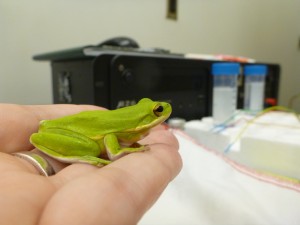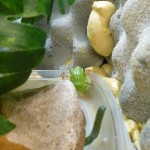 The Gall Lab, in collaboration with Walt Wilczynski at Georgia State University has just published a paper entitled “Hearing conspecific vocal signals alters peripheral auditory sensitivity”. But, what does that mean?
The Gall Lab, in collaboration with Walt Wilczynski at Georgia State University has just published a paper entitled “Hearing conspecific vocal signals alters peripheral auditory sensitivity”. But, what does that mean?
Well, many animals (including humans) are exposed to the vocalizations of conspecifics (individuals of the same species) over long periods of time. We have known for a long time that if you hear the same thing over and over you will habituate to that sound. That means you’ll stop paying attention to sounds that don’t give you new information. This is why moms are surprisingly good at tuning out shoutings of “Mom . . . mom . . . mom. . . mom”. What has been less clear, however, is what happens to your auditory system when you are exposed to lots of different sounds, especially when we are talking about peripheral auditory structures like the ear and auditory nerve (the nerve that runs from the ear to the brain).
We decided to explore this idea in the green treefrog. Treefrogs are adorable little guys that form leks. Leks are large assemblages (usually near ponds) where males call and call and call in an effort to attract a mate. This can go on for weeks, so individuals in the area will hear lots of different males call over a long period of time. We replicated this in the lab by housing frogs in acoustically-isolated chambers and playing the sound of a frog chorus to half of the frogs. As a control, we played random tones to the other half of the frogs.
We tested the hearing of the animals before and after they were exposed to these sounds. We found that animals that had listened to the chorus for ten days had improved hearing, while animals that had listened to the tones didn’t change much. This suggests to us that the auditory system – even at the level of the ear! – is able to change over a short period of time. More importantly, the social stimuli that an animal is exposed to during its lifetime are very important in shaping its future auditory processing abilities. This is the first time that this has been shown in an adult animal. To find out more, check out our article!
Gall M.D., Wilczynski W. 2015 Hearing conspecific vocal signals alters peripheral auditory sensitivity.Proceedings of the Royal Society B, 282: 20150749. Find it here!



how the behavior of the frog if it get hungry?